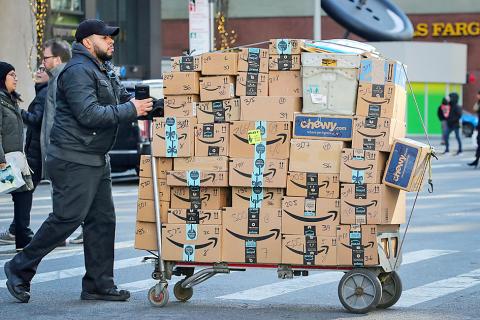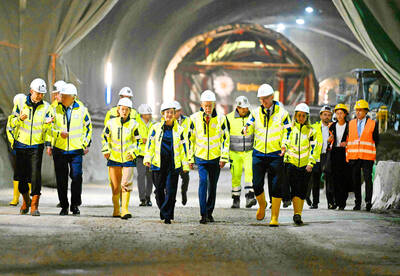Amazon.com Inc’s efforts to get packages from warehouse to doorstep in a single day helped push the retail giant to its first year-on-year quarterly profit decline since early 2017 and the spending binge is not over.
Amazon chief financial officer Brian Olsavsky on Thursday said that the costs of the company’s one-day delivery push would be about US$1.5 billion during the fourth quarter.
Amazon’s forecasts for operating income and sales in the period fell short of analysts’ estimates and its shares slumped as much as 9.1 percent in extended trading.

Photo: Reuters
Amazon chief executive Jeff Bezos has promised since the company’s initial public offering to invest for the long haul and he is proving again his willingness to endure a little short-term pain in a bid to expand.
Facing slowing growth in its core e-commerce business, Amazon in April announced an initiative to cut the delivery window on millions of items for paying members of its Prime subscription program.
That has helped reinvigorate sales, if at a high price.
“Customers love the transition of Prime from two days to one day — they’ve already ordered billions of items with free one-day delivery this year,” Bezos said in a statement. “It’s a big investment and it’s the right long-term decision for customers.”
The investments taking place across Amazon’s warehouses are “strategically necessary,” but they “continued to weigh heavily” on the profitability of the retail business, Moody’s Investors Service analyst Charlie O’Shea said.
Third-quarter net income narrowed to US$2.13 billion, or earnings per share of US$4.23, from US$2.88 billion, or US$5.75, a year earlier, the Seattle-based company said in the statement.
It was the first year-on-year decline since the second quarter of 2017.
Analysts, on average, forecast earnings per share of US$4.59, data compiled by Bloomberg showed.
Amazon forecast operating income of between US$1.2 billion and US$2.9 billion in the fourth quarter compared with analysts’ estimates of US$4.31 billion.
Sales would be US$80 billion to US$86.5 billion in the holiday period, the company said. Analysts forecast US$87.2 billion.
Operating expenses during the third quarter climbed 26 percent, the steepest rise in more than a year, to US$66.8 billion. Shipping costs soared 46 percent to US$9.6 billion.
Delivery is hardly the only place Amazon is investing.
Amazon’s costs for technology and content — largely salaries related to employees in research and development, as well as infrastructure for Amazon Web Services (AWS) Inc data centers — jumped 28 percent to US$9.2 billion.
The company’s total workforce increased 22 percent to 750,000.
While the shares have gained 19 percent this year to close at US$1,780.78 in New York on Thursday, they have fallen 12 percent since the July 15 high of US$2,020.99.
Investors had bid up Amazon shares on growing profits driven by AWS, services for third-party sellers and advertising.
The cloud-computing unit remains Amazon’s cash cow.
Sales rose 35 percent to about US$9 billion in the third quarter. The unit’s operating income, US$2.26 billion, accounted for more than two-thirds of the total.
However, growth at AWS was the slowest since Amazon began breaking out the unit’s performance.
That is “absolutely” a concern for investors, D.A. Davidson & Co analyst Tom Forte said.
Amazon, which had a lengthy head start in building out a cloud-computing platform, faces steep competition from well-funded rivals such as Microsoft Corp’s Azure and Google’s Cloud Platform.
“You’re seeing some incremental competitive pressure from Microsoft” in particular, Forte said.
Revenue gained 24 percent to US$70 billion in the third quarter. Analysts had forecast US$68.7 billion.

CHIP RACE: Three years of overbroad export controls drove foreign competitors to pursue their own AI chips, and ‘cost US taxpayers billions of dollars,’ Nvidia said China has figured out the US strategy for allowing it to buy Nvidia Corp’s H200s and is rejecting the artificial intelligence (AI) chip in favor of domestically developed semiconductors, White House AI adviser David Sacks said, citing news reports. US President Donald Trump on Monday said that he would allow shipments of Nvidia’s H200 chips to China, part of an administration effort backed by Sacks to challenge Chinese tech champions such as Huawei Technologies Co (華為) by bringing US competition to their home market. On Friday, Sacks signaled that he was uncertain about whether that approach would work. “They’re rejecting our chips,” Sacks

NATIONAL SECURITY: Intel’s testing of ACM tools despite US government control ‘highlights egregious gaps in US technology protection policies,’ a former official said Chipmaker Intel Corp has tested chipmaking tools this year from a toolmaker with deep roots in China and two overseas units that were targeted by US sanctions, according to two sources with direct knowledge of the matter. Intel, which fended off calls for its CEO’s resignation from US President Donald Trump in August over his alleged ties to China, got the tools from ACM Research Inc, a Fremont, California-based producer of chipmaking equipment. Two of ACM’s units, based in Shanghai and South Korea, were among a number of firms barred last year from receiving US technology over claims they have

It is challenging to build infrastructure in much of Europe. Constrained budgets and polarized politics tend to undermine long-term projects, forcing officials to react to emergencies rather than plan for the future. Not in Austria. Today, the country is to officially open its Koralmbahn tunnel, the 5.9 billion euro (US$6.9 billion) centerpiece of a groundbreaking new railway that will eventually run from Poland’s Baltic coast to the Adriatic Sea, transforming travel within Austria and positioning the Alpine nation at the forefront of logistics in Europe. “It is Austria’s biggest socio-economic experiment in over a century,” said Eric Kirschner, an economist at Graz-based Joanneum

OPTION: Uber said it could provide higher pay for batch trips, if incentives for batching is not removed entirely, as the latter would force it to pass on the costs to consumers Uber Technologies Inc yesterday warned that proposed restrictions on batching orders and minimum wages could prompt a NT$20 delivery fee increase in Taiwan, as lower efficiency would drive up costs. Uber CEO Dara Khosrowshahi made the remarks yesterday during his visit to Taiwan. He is on a multileg trip to the region, which includes stops in South Korea and Japan. His visit coincided the release last month of the Ministry of Labor’s draft bill on the delivery sector, which aims to safeguard delivery workers’ rights and improve their welfare. The ministry set the minimum pay for local food delivery drivers at